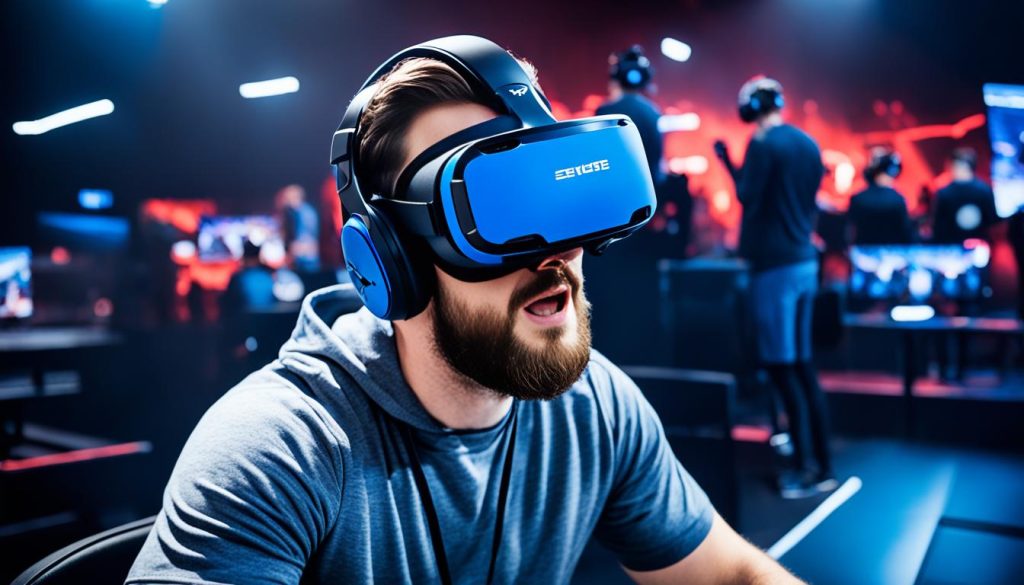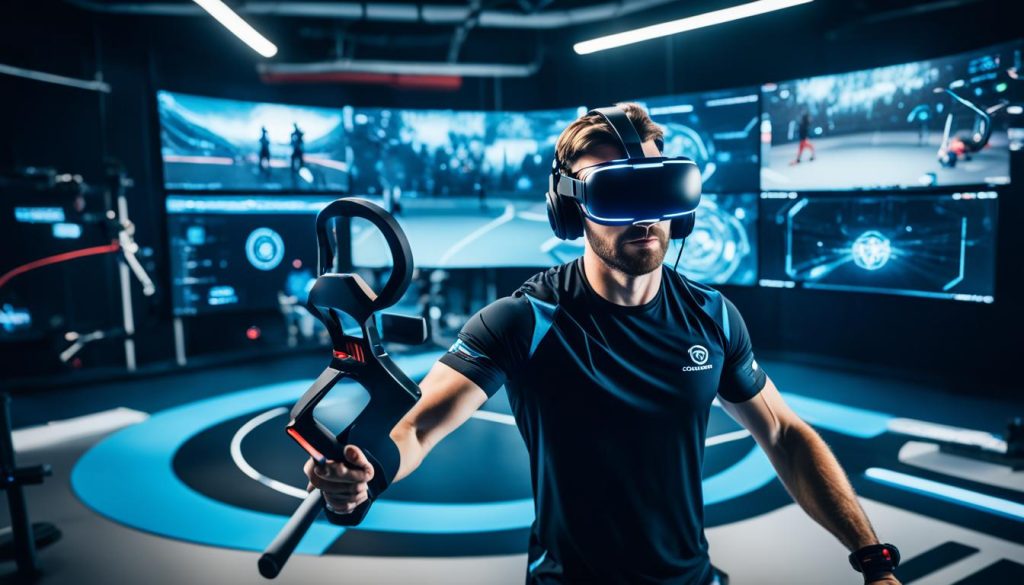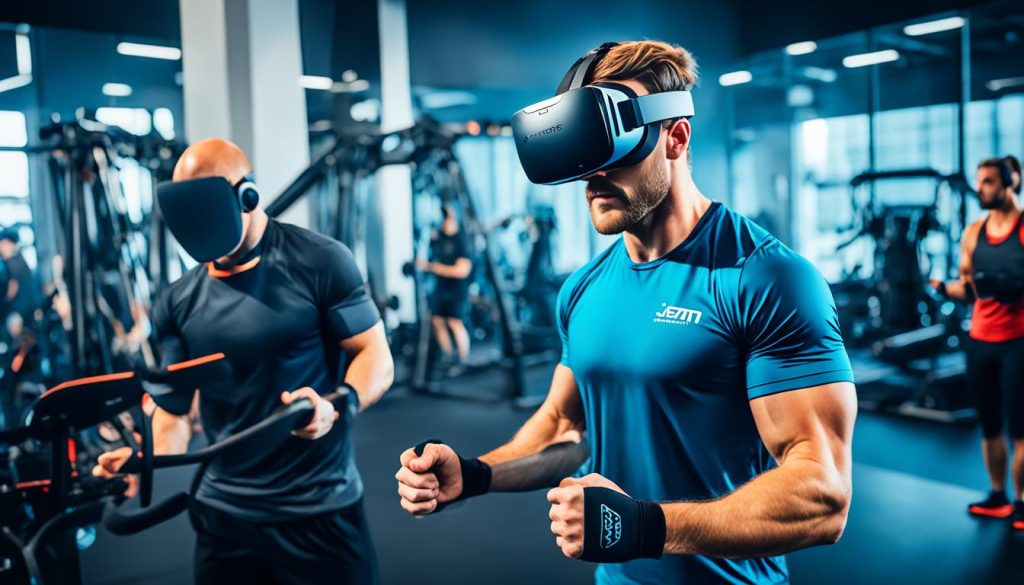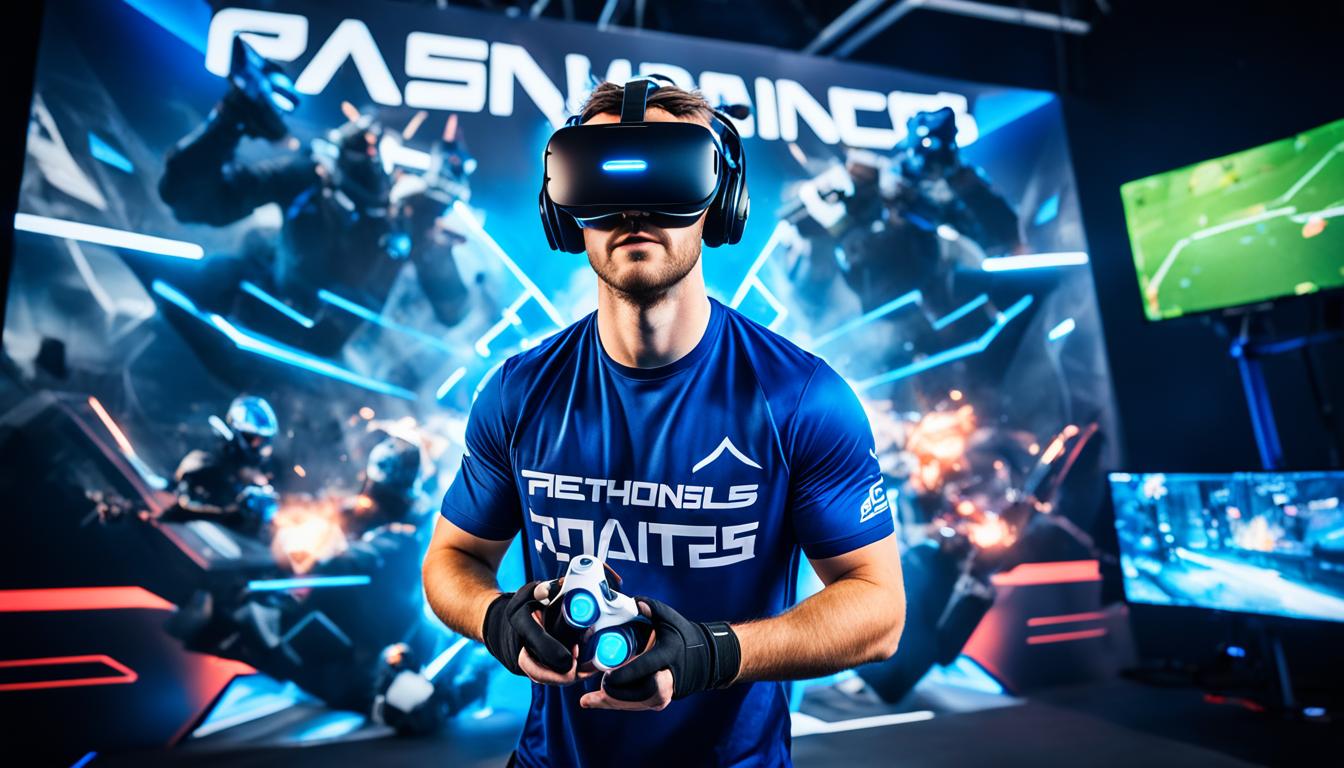Virtual reality has revolutionized the training methods for esports athletes, enabling them to practice in immersive simulated environments that provide a realistic and risk-free way to develop their skills. By using VR technology, esports athletes can hone their reflexes, decision-making, and mental resilience in a controlled setting, without the physical risks associated with traditional training methods. VR allows for the creation of customized scenarios that replicate the intensity and unpredictability of live competitions, helping players prepare for high-pressure situations. Additionally, VR-based training can collect valuable performance data, enabling coaches to analyze and optimize their athletes’ development. The integration of gaming technology and esports has opened up new frontiers in competitive training, transforming the way esports athletes prepare for success.
Key Takeaways
- Virtual reality revolutionizes esports training, providing a realistic and risk-free environment
- VR technology enhances the development of reflexes, decision-making, and mental resilience
- Customized VR scenarios replicate the intensity and unpredictability of live esports competitions
- VR-based training collects valuable performance data for coaches to analyze and optimize athletes
- The convergence of gaming technology and esports has transformed competitive training methods
Mitigating Head Injuries: VR’s Potential Impact
The growing awareness around head injuries in sports, particularly in contact sports like American football, rugby, and soccer, has led to a search for safer training alternatives. Chronic Traumatic Encephalopathy (CTE), a progressive degenerative brain disease, has been linked to repetitive head impacts experienced by many athletes. VR technology offers a solution by providing a controlled training environment that can significantly reduce the risk of head injuries. By simulating game scenarios without the physical contact, esports athletes can develop their skills and strategies without exposing themselves to the cumulative effects of repetitive head impacts. This shift towards safer training methods using VR can help mitigate the long-term consequences of CTE and ensure the well-being of esports athletes.
Reducing Repetitive Head Impacts in Contact Sports
Virtual reality training can help reduce the risk of repetitive head impacts in contact sports by allowing athletes to practice specific skills and techniques without the physical contact that can lead to concussions and other head injuries. By simulating game scenarios in a virtual environment, esports athletes can develop their decision-making, reaction time, and spatial awareness without subjecting themselves to the cumulative effects of repetitive head impacts. This approach can be particularly beneficial for sports like soccer, where heading the ball has been linked to an increased risk of brain injuries. VR training provides a safe and controlled way for athletes to hone their skills without the need for physical contact, ultimately protecting their long-term brain health.
The Role of Virtual Reality in Safer Training
Virtual reality has emerged as a powerful tool for safer training in esports, providing a risk-free environment for athletes to develop their skills and strategies. By simulating game scenarios and high-pressure situations, VR allows esports athletes to practice and refine their techniques without the physical contact that can lead to head injuries. This controlled training environment helps mitigate the risk of repetitive head impacts, which have been linked to the development of chronic traumatic encephalopathy (CTE) and other long-term brain conditions. The use of VR in esports training not only enhances skill development but also prioritizes the physical and cognitive well-being of the athletes, ensuring their long-term success and safety.
Immersive and Controlled Training Environments
Virtual reality technology has enabled the creation of highly immersive and controlled training environments for esports athletes. These VR simulations can replicate the intensity, unpredictability, and dynamic nature of live esports competitions, allowing athletes to practice and refine their skills in a risk-free setting. By simulating realistic in-game scenarios, esports athletes can develop their reflexes, decision-making abilities, and strategic decision-making without the physical risks associated with traditional training methods. The level of realism and customization offered by VR-based training ensures that athletes can focus on honing their specific skills and techniques, leading to enhanced performance and a competitive edge in live tournaments.
Realistic Simulations for Skill Development
These VR-powered training environments provide esports athletes with the opportunity to practice and develop their skills in a highly realistic and immersive setting. By recreating the intensity and unpredictability of live esports competitions, these simulations allow athletes to hone their reflexes, decision-making abilities, and strategic planning without the physical risks associated with traditional training methods. The level of detail and customization within these VR environments ensures that athletes can focus on refining their specific skills and techniques, leading to enhanced performance and a competitive edge when competing in live tournaments.
Adaptability and Customization
One of the key advantages of using virtual reality for esports training is the adaptability and customization it offers. VR-based training environments can be tailored to the specific needs and goals of individual athletes or teams, allowing for the creation of personalized scenarios that address their unique strengths, weaknesses, and areas for improvement. Coaches and trainers can adjust the difficulty, environmental factors, and even the behavior of virtual opponents to challenge athletes in ways that reflect the dynamics of live esports competitions. This level of adaptability enables a more targeted and effective training approach, helping esports athletes develop the skills and mental fortitude required to excel in the ever-evolving world of competitive gaming.

| Key Advantages of VR-based Esports Training | Description |
|---|---|
| Immersive and Controlled Environments | VR simulations can replicate the intensity, unpredictability, and dynamic nature of live esports competitions, allowing athletes to practice in a risk-free setting. |
| Realistic Skill Development | Esports athletes can hone their reflexes, decision-making abilities, and strategic planning in highly realistic in-game scenarios. |
| Adaptability and Customization | VR-based training environments can be tailored to the specific needs and goals of individual athletes or teams, enabling a more targeted and effective training approach. |
Game Engines: Powering VR Training Experiences
The integration of game engines has been instrumental in powering the immersive and realistic VR training experiences for esports athletes. These powerful software platforms, typically used in the development of video games, provide the underlying technology and tools to create highly detailed, responsive, and customizable virtual environments. Game engines like Unreal Engine and Unity, with their advanced graphics, physics simulations, and artificial intelligence capabilities, enable the development of VR training scenarios that closely mimic the real-world dynamics of esports competitions.
By leveraging the capabilities of these game engines, esports teams and trainers can design tailored training simulations that challenge athletes, measure their performance, and provide valuable insights to optimize their development. The advancements in game engine technology have been a driving force behind the integration of virtual reality into the training regimens of esports athletes, elevating their preparation for success in the digital arena.
Game engines like Unreal Engine and Unity, with their advanced graphics, physics simulations, and artificial intelligence capabilities, enable the development of VR training scenarios that closely mimic the real-world dynamics of esports competitions. By leveraging the capabilities of these game engines, esports teams and trainers can design tailored training simulations that challenge athletes, measure their performance, and provide valuable insights to optimize their development.
Cognitive and Tactical Training with VR
Virtual reality not only enhances the physical training of esports athletes but also provides a powerful platform for cognitive and tactical development. VR simulations can recreate high-pressure scenarios that challenge athletes’ decision-making abilities, forcing them to make quick and strategic choices in the face of intense in-game situations. By immersing players in these dynamic environments, VR training helps develop their mental resilience, problem-solving skills, and the ability to perform under stress. Esports athletes can practice their tactical decision-making, anticipating the actions of opponents, and executing coordinated team strategies, all without the physical risks associated with live competitions. This cognitive and tactical training using VR technology is crucial in preparing esports athletes for the mental demands of professional-level gameplay, giving them a competitive edge in the digital arena.
Decision-Making Under Pressure
In addition to enhancing decision-making skills, VR-based training also plays a vital role in developing the mental resilience and stress management capabilities of esports athletes. By simulating high-pressure, fast-paced gaming scenarios, VR environments can induce the same levels of intensity and psychological stress that players would experience in live competitions. Through repeated exposure to these challenging situations, esports athletes can learn to regulate their emotions, maintain focus, and perform under intense pressure. This mental training using VR technology helps build the cognitive stamina and coping mechanisms necessary for success in the highly competitive world of esports. By addressing the mental and emotional aspects of competitive gaming, VR training equips esports athletes with the resilience and stress management skills required to thrive in the digital arena.

Gaming Technology and Esports
The convergence of gaming technology and the rapidly growing esports industry has opened up a vast array of opportunities for the integration of virtual reality (VR) and other extended reality (XR) technologies. Esports, with its emphasis on lightning-fast reflexes, strategic decision-making, and intense competitive environments, is particularly well-suited for the immersive and customizable training experiences offered by VR. From realistic in-game simulations to cognitive and tactical exercises, VR applications are revolutionizing the way esports athletes prepare for live competitions. These VR-powered training tools allow for the development of essential skills, such as split-second decision-making, spatial awareness, and mental resilience, all while minimizing the physical risks associated with traditional training methods. As the esports industry continues to evolve, the synergy between gaming technology and VR is poised to redefine the way esports athletes train, compete, and push the boundaries of what is possible in the digital arena.
Esports VR Applications
The integration of VR technology into esports training not only enhances the development of essential skills but also provides valuable data and analytics for player performance analysis. VR-based training systems can collect a wealth of information, such as reaction times, decision-making patterns, and movement patterns, which can then be analyzed by coaches and trainers to identify areas for improvement. This data-driven approach allows esports teams to fine-tune their training strategies, optimize player development, and make informed decisions about team composition and strategy. By leveraging the data-capturing capabilities of VR, esports organizations can gain deeper insights into the strengths, weaknesses, and potential of their athletes, ultimately giving them a competitive edge in the fast-paced and ever-evolving world of esports.
Enhancing Spectator Experiences
The impact of VR and other extended reality (XR) technologies extends beyond the training and development of esports athletes – it is also transforming the spectator experience. By immersing fans in virtual stadiums and arenas, VR allows them to witness the action unfold from the front row, providing a level of immersion and engagement that traditional broadcasts cannot match. Fans can choose from multiple perspectives, follow their favorite players’ viewpoints, and even interact with the virtual environment, fostering a deeper connection to the esports competition. This heightened sense of presence and interactivity enhances the overall spectator experience, bringing fans closer to the heart of the action and amplifying the excitement and passion of esports viewership. As VR technology continues to evolve, the potential for even more captivating and innovative spectator experiences in the esports realm is vast, further driving the growth and popularity of this dynamic industry.
Immersive Virtual Stadiums
Virtual reality and other XR technologies are not only transforming the way fans experience esports competitions, but also introducing new levels of interactivity and engagement. Through VR-powered virtual stadiums and arenas, spectators can immerse themselves in the action, choosing their preferred viewing angles and even interacting with various elements of the environment. This enhanced interactivity goes beyond passive viewership, allowing fans to feel as if they are part of the event, influencing the narrative and even participating in virtual challenges alongside the professional players.
Interactive and Engaging Viewership
The integration of interactive features, such as voting on in-game events or influencing the course of a match, further strengthens the connection between fans and the esports ecosystem. By blurring the lines between spectator and participant, VR-powered esports viewership creates a more engaging, dynamic, and community-driven experience that resonates with the growing legions of esports enthusiasts.
Gamification and Motivation
The fusion of gaming technology and esports has also introduced new opportunities for gamification and the creation of engaging fitness experiences. VR-based esports training and simulations not only enhance the skills of professional athletes but can also provide a fun and accessible way for recreational players to stay active and improve their physical fitness. By blending the entertainment value of video games with the benefits of physical exercise, VR fitness experiences can motivate individuals who may otherwise struggle to maintain a consistent fitness routine.
Engaging Fitness Experiences
The immersive and interactive nature of these VR games, which often involve full-body movements and intensive gameplay, can seamlessly integrate fitness into the gaming experience, making it more enjoyable and sustainable for a wider audience. As the convergence of gaming, esports, and fitness continues to evolve, the potential for innovative and engaging VR-powered fitness experiences to emerge and inspire greater participation in physical activity is substantial.

Challenges and Future Advancements
While the integration of virtual reality and other extended reality (XR) technologies into the esports ecosystem has been transformative, there are still certain technological limitations that need to be addressed. The cost and accessibility of high-quality VR hardware, such as headsets and tracking systems, can be prohibitive for some esports organizations and individual athletes. Additionally, the computing power and infrastructure required to deliver seamless and responsive VR experiences in a competitive gaming environment can present challenges, particularly for smaller or less-resourced teams. As the technology continues to evolve, addressing these limitations in terms of cost, performance, and scalability will be crucial to ensure widespread adoption and accessibility within the esports industry. Overcoming these technical hurdles will pave the way for even more immersive, customizable, and data-driven VR training experiences that can elevate the performance of esports athletes at all levels.
Technological Limitations
In addition to the technological limitations, the integration of VR and XR technologies into esports also presents challenges related to infrastructure and accessibility. Ensuring that the necessary hardware, software, and connectivity are available and accessible to esports organizations, teams, and individual players is crucial for the widespread adoption and effective utilization of these advanced training and spectator experience tools. Building the infrastructure to support the seamless integration of VR and XR technologies, from low-latency network infrastructure to cloud-based computing resources, will be a key priority for the esports industry as it continues to evolve. Furthermore, addressing the accessibility of these technologies, both in terms of cost and user-friendliness, will be vital to ensuring that the benefits of VR-powered esports training and experiences are available to a diverse range of athletes and fans. As the industry continues to grow, addressing these infrastructure and accessibility challenges will be essential for the long-term success and widespread integration of VR and XR technologies in the esports ecosystem.
Infrastructure and Accessibility
While the integration of virtual reality and other extended reality (XR) technologies into the esports ecosystem has been transformative, there are still certain technological limitations that need to be addressed. The cost and accessibility of high-quality VR hardware, such as headsets and tracking systems, can be prohibitive for some esports organizations and individual athletes. Additionally, the computing power and infrastructure required to deliver seamless and responsive VR experiences in a competitive gaming environment can present challenges, particularly for smaller or less-resourced teams. As the technology continues to evolve, addressing these limitations in terms of cost, performance, and scalability will be crucial to ensure widespread adoption and accessibility within the esports industry. Overcoming these technical hurdles will pave the way for even more immersive, customizable, and data-driven VR training experiences that can elevate the performance of esports athletes at all levels.
Conclusion
In the rapidly evolving world of esports, the integration of virtual reality and other extended reality (XR) technologies has revolutionized the way athletes train, compete, and captivate audiences. By harnessing the power of gaming technology, esports organizations have unlocked a new frontier in competitive training, where immersive VR simulations allow athletes to sharpen their reflexes, decision-making, and mental resilience in a risk-free environment.
The convergence of VR, game engines, and artificial intelligence has enabled the creation of highly customizable and data-driven training experiences, empowering coaches to optimize the development of their esports athletes. From mitigating the risk of head injuries to enhancing cognitive and tactical skills, the integration of these advanced technologies has transformed the esports landscape, elevating the performance and well-being of players at all levels.
As the esports industry continues to evolve, the potential for further advancements in VR and XR technology is vast. Overcoming the challenges of cost, accessibility, and infrastructure will be crucial in ensuring that the benefits of these immersive training and spectator experiences are widely accessible. By embracing the synergy between gaming technology and the growing esports ecosystem, we are witnessing a new era of competitive excellence, where the boundaries of human performance are being continuously redefined.
FAQ
How is virtual reality revolutionizing training for esports athletes?
How can VR help reduce the risk of head injuries in esports?
What are the key advantages of using virtual reality for esports training?
How do game engines power the immersive VR training experiences for esports athletes?
How does VR-based training help develop the cognitive and tactical skills of esports athletes?
How is the integration of gaming technology and esports transforming the spectator experience?
What are the challenges and future advancements in integrating VR and XR technologies into the esports ecosystem?
Source Links
- https://www.scienceforsport.com/virtual-reality-for-sports-training/
- https://medium.com/@ssmore101/how-virtual-reality-augmented-reality-and-mixed-reality-are-changing-the-face-of-esports-b7846a91b5b2
- https://www.picoxr.com/global/blog/vr-sports-game-changing-exercise
